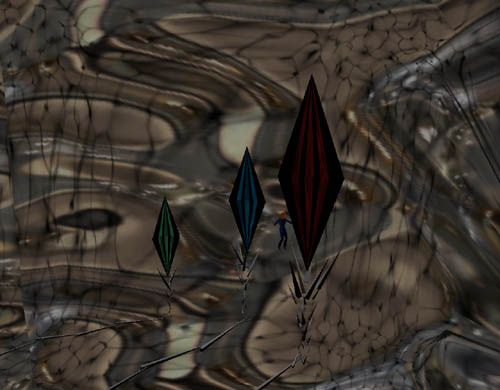|
Welcome to a critical review of virtual culture |
WHAT |
||||
| click on these links for: | RSS feed | Features | BLOG | Editorials | Contact |
|
Welcome to a critical review of virtual culture |
WHAT |
||||
| click on these links for: | RSS feed | Features | BLOG | Editorials | Contact |
|
Kiss the Sky
|
|

|
From the outside this work has the appearance of a liquid crystal, like a giant ice cube melting in a glass of scotch. Inside is a surreal dreamscape, evoking a Daliesque experience that reminded me of Hichcock's Spellbound, with Tanguy or Matta influenced objects hanging in space. In order to view Nebulosus Severine's Pulse Points (I, II, III) properly, it is necessary to fly through it and get close to the red, blue and green objects within. Sound elements are triggered by proximity. Art historical references are employed directly
in the sculptural set by Vlad Bjornson titled Plant Deco (below), with individual
works sub-titled mondrian, de chirico, pollock and rothko. I would
suggest Archipenko.
The titles relate to the palettes Vlad has chosen
for each sculpture. When you click on one of them it changes shape. |
|
Although much of the Hyperformalist work is abstract, figuration is used, as in DanCoyote's Exploding Starax, which we reviewed in an earlier exhibition, with its art historical references to Picasso, Bernini, and Starax, one of the earliest artists to use the Second Life platform to create monumental artworks. DC views is as "a transition between remediation and hyperformalism," as it appears static at a distance, but as you approach it your proximity blows it apart.
To the left above is a picture of me sitting on a tour cushion approaching Juria Yoshikawa's Spots Prop #9 Tower. This sculpture cycles through a series of changes. To the right is a deail of another phase. | |